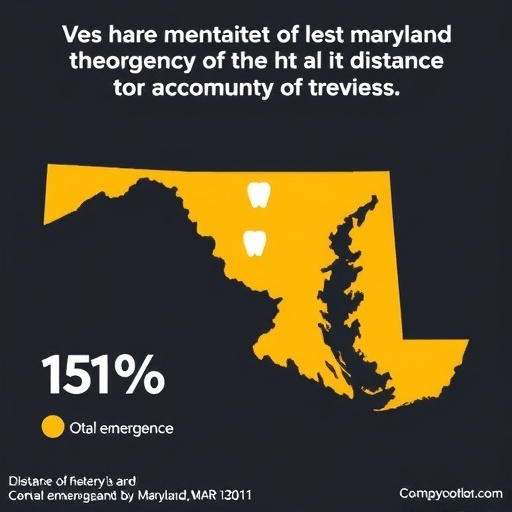In a striking new study published in BMC Health Services Research, researchers have uncovered the significant impact of geographic distance on the utilization of emergency departments (EDs) for non-traumatic dental conditions in Maryland, USA. This research, conducted between 2017 and 2021, takes a fresh look at how location influences healthcare decisions, particularly in the realm of dental emergencies. The findings shed light on the complex interplay between patient accessibility, emergency services, and the broader implications for public health policy.
Emergency departments have historically been a frontline resource for patients experiencing acute health crises. For dental issues, however, this trend raises critical questions. While many dental conditions are non-life-threatening, the urgency of treatment can propel patients to seek assistance in EDs rather than traditional dental offices. The research team, led by Uditi Kelekar, investigated this phenomenon with rigorous statistical methods, probing how distance from dental care facilities affected patients’ choices. The implications of their findings could shape future healthcare accessibility initiatives.
One striking observation from the study is that patients living further away from dental care facilities are more likely to turn to emergency departments for their dental issues. This observation highlights a critical barrier to accessing preventative and timely dental care. The participants, whose demographics and locations varied widely, provided a comprehensive view of how distance can alter the decision-making process regarding emergency care access. Interestingly, it appears that long travel times often correlate with increased reliance on emergency services, reflecting an underlying issue of accessibility in dental care.
Furthermore, the study also examined the socioeconomic status of patients in relation to their distance from dental services. The researchers found that low-income patients tend to experience more significant challenges in accessing usual dental care. This demographic is often more vulnerable, lacking transportation and financial resources, which exacerbates reliance on emergency care as a stopgap solution. Underlying these statistics is an urgent need for multidisciplinary strategies to improve access to dental health services in underserved communities.
In comparing urban and rural patients, the disparities in access became even more evident. Urban residents frequently face an overload of emergency services, while rural residents encounter travel distances that can exceed an hour to reach their nearest dental facility. As a result, the authors underscored the need for targeted public health initiatives that address the unique constraints of both demographic groups. Without these interventions, the cycle of dependent emergency care will likely continue, leading to deteriorating oral health outcomes.
Patient education is also a crucial aspect highlighted in the research. By fostering a better understanding of dental health and the importance of regular check-ups, individuals may be more inclined to seek preventative care rather than resorting to emergency services for issues that could have been managed through routine visits. This calls for a dual approach where both providers and patients are empowered with knowledge, making it clear that timely dental care can prevent dire situations that necessitate emergency treatment.
The findings of Kelekar et al. are particularly relevant for policymakers as they look to enhance healthcare delivery systems. To address gaps identified in the study, strategies for improving access to dental care among disadvantaged populations must be prioritized. This could involve increasing the availability of mobile dental clinics, subsidizing transportation costs for low-income patients, or expanding tele-dentistry services. Policymakers can leverage the insights from this study to advocate for a more equitable healthcare system that ensures patients receive the necessary services before their conditions escalate into emergencies.
The role of community outreach cannot be understated in these efforts. Local health departments can play a vital role in connecting patients with available dental resources and educating them about appropriate treatment pathways—significantly alleviating some of the burdens placed on emergency departments. Engaging local organizations in outreach efforts can lead to improved health literacy, paving the way for more effective management of dental conditions before they develop into emergencies.
Researchers emphasize that bridging the gap between dental services and emergency care is essential to improve overall public health outcomes. By addressing the geographic and socioeconomic barriers identified in their analysis, stakeholders can create systems that more effectively serve populations in need. Investments in community health programming and preventive care will not only ease the burden on emergency departments but also foster healthier communities.
Additionally, the research raises awareness about the importance of data collection and management in understanding healthcare utilization patterns. Collecting demographic data related to distances traveled for dental care can inform future research and healthcare strategies, allowing for tailored approaches aimed at mitigating the issues faced by various populations. Helping researchers build comprehensive databases could lead to a more robust understanding of the context surrounding dental emergencies, ultimately fostering innovations in treatment and access.
In conclusion, the study conducted by Kelekar, Naavaal, and Turner unfolds a vital discourse surrounding the implications of geographic distance on emergency dental care utilization. The research paints a picture of a systemic issue that calls for urgent attention from healthcare providers, policymakers, and community organizations alike. The findings advocate for a shift towards more integrated health services that acknowledge the complexities of patient access. By addressing the key factors outlined, there exists an opportunity not only to improve health outcomes but also to initiate a broader dialogue on healthcare access and equity in America.
The innovative thinking present in this research could usher in a new era of dental health awareness and preparedness nationwide, underscoring the crucial role of proximity in healthcare decisions. Only by unearthing these underlying issues can the community health landscape shift, improving outcomes for patients and alleviating the pressure on emergency systems across the nation.
Subject of Research: Geographic distance’s impact on emergency department utilization for non-traumatic dental conditions.
Article Title: Role of distance in the utilization of emergency departments for non-traumatic dental conditions in Maryland, USA, 2017–2021.
Article References:
Kelekar, U., Naavaal, S. & Turner, S.C. Role of distance in the utilization of emergency departments for non-traumatic dental conditions in Maryland, USA, 2017–2021.
BMC Health Serv Res 25, 1363 (2025). https://doi.org/10.1186/s12913-025-13523-w
Image Credits: AI Generated
DOI:
Keywords: Emergency departments, dental care, healthcare access, public health policy, Maryland.
Tags: dental care facility accessibilitydental emergencies in rural areasdistance and dental emergency visitsemergency department utilization for dental issuesemergency services for dental caregeographic distance and health decisionshealthcare research in Marylandimpact of location on healthcare choicesMaryland healthcare accessibilitynon-traumatic dental conditionspatient accessibility to dental carepublic health policy implications





